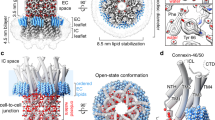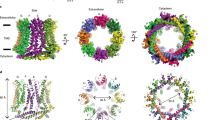Abstract
Lens-specific aquaporin-0 (AQP0) functions as a specific water pore and forms the thin junctions between fibre cells. Here we describe a 1.9 Å resolution structure of junctional AQP0, determined by electron crystallography of double-layered two-dimensional crystals. Comparison of junctional and non-junctional AQP0 structures shows that junction formation depends on a conformational switch in an extracellular loop, which may result from cleavage of the cytoplasmic amino and carboxy termini. In the centre of the water pathway, the closed pore in junctional AQP0 retains only three water molecules, which are too widely spaced to form hydrogen bonds with each other. Packing interactions between AQP0 tetramers in the crystalline array are mediated by lipid molecules, which assume preferred conformations. We were therefore able to build an atomic model for the lipid bilayer surrounding the AQP0 tetramers, and we describe lipid–protein interactions.
This is a preview of subscription content, access via your institution
Access options
Subscribe to this journal
Receive 51 print issues and online access
$199.00 per year
only $3.90 per issue
Buy this article
- Purchase on Springer Link
- Instant access to full article PDF
Prices may be subject to local taxes which are calculated during checkout




Similar content being viewed by others
References
Agre, P. et al. Aquaporin water channels—from atomic structure to clinical medicine. J. Physiol. (Lond.) 542, 3–16 (2002)
Murata, K. et al. Structural determinants of water permeation through aquaporin-1. Nature 407, 599–605 (2000)
Fu, D. et al. Structure of a glycerol-conducting channel and the basis for its selectivity. Science 290, 481–486 (2000)
Sui, H., Han, B. G., Lee, J. K., Walian, P. & Jap, B. K. Structural basis of water-specific transport through the AQP1 water channel. Nature 414, 872–878 (2001)
Ren, G., Reddy, V. S., Cheng, A., Melnyk, P. & Mitra, A. K. Visualization of a water-selective pore by electron crystallography in vitreous ice. Proc. Natl Acad. Sci. USA 98, 1398–1403 (2001)
Savage, D. F., Egea, P. F., Robles-Colmenares, Y., O'Connell, J. D. & Stroud, R. M. Architecture and selectivity in aquaporins: 2.5 Å X-ray structure of aquaporin Z. PLoS Biol. 1, E72 (2003)
Gonen, T., Sliz, P., Kistler, J., Cheng, Y. & Walz, T. Aquaporin-0 membrane junctions reveal the structure of a closed water pore. Nature 429, 193–197 (2004)
Harries, W. E., Akhavan, D., Miercke, L. J., Khademi, S. & Stroud, R. M. The channel architecture of aquaporin 0 at a 2.2-Å resolution. Proc. Natl Acad. Sci. USA 101, 14045–14050 (2004)
de Groot, B. L. & Grubmuller, H. The dynamics and energetics of water permeation and proton exclusion in aquaporins. Curr. Opin. Struct. Biol. 15, 176–183 (2005)
Kistler, J. & Bullivant, S. Lens gap junctions and orthogonal arrays are unrelated. FEBS Lett. 111, 73–78 (1980)
Gonen, T., Cheng, Y., Kistler, J. & Walz, T. Aquaporin-0 membrane junctions form upon proteolytic cleavage. J. Mol. Biol. 342, 1337–1345 (2004)
Nemeth-Cahalan, K. L., Kalman, K. & Hall, J. E. Molecular basis of pH and Ca2+ regulation of aquaporin water permeability. J. Gen. Physiol. 123, 573–580 (2004)
Gyobu, N. et al. Improved specimen preparation for cryo-electron microscopy using a symmetric carbon sandwich technique. J. Struct. Biol. 146, 325–333 (2004)
Fujiyoshi, Y. The structural study of membrane proteins by electron crystallography. Adv. Biophys. 35, 25–80 (1998)
Brunger, A. T. et al. Crystallography & NMR system: a new software suite for macromolecular structure determination. Acta Crystallogr. D Biol. Crystallogr. 54, 905–921 (1998)
Roy, D., Spector, A. & Farnsworth, P. N. Human lens membrane: comparison of major intrinsic polypeptides from young and old lenses isolated by a new methodology. Exp. Eye Res. 28, 353–358 (1979)
Takemoto, L., Takehana, M. & Horwitz, J. Covalent changes in MIP26K during aging of the human lens membrane. Invest. Ophthalmol. Vis. Sci. 27, 443–446 (1986)
Laskowski, R. A., MacArthur, M. W., Moss, D. S. & Thornton, J. M. PROCHECK: a program to check the stereochemical qaulity of protein structures. J. Appl. Crystallogr. 26, 283–291 (1993)
Vriend, G. WHAT IF: a molecular modeling and drug design program. J. Mol. Graph. 8, 526–529 (1990)
Wang, Y., Schulten, K. & Tajkhorshid, E. What makes an aquaporin a glycerol channel? A comparative study of AqpZ and GlpF. Structure 13, 1107–1118 (2005)
de Groot, B. L. & Grubmuller, H. Water permeation across biological membranes: mechanism and dynamics of aquaporin-1 and GlpF. Science 294, 2353–2357 (2001)
Zhu, F., Tajkhorshid, E. & Schulten, K. Molecular dynamics study of aquaporin-1 water channel in a lipid bilayer. FEBS Lett. 504, 212–218 (2001)
Tajkhorshid, E. et al. Control of the selectivity of the aquaporin water channel family by global orientational tuning. Science 296, 525–530 (2002)
Ball, L. E. et al. Water permeability of C-terminally truncated aquaporin 0 (AQP0 1–243) observed in the aging human lens. Invest. Ophthalmol. Vis. Sci. 44, 4820–4828 (2003)
Luecke, H., Schobert, B., Richter, H. T., Cartailler, J. P. & Lanyi, J. K. Structure of bacteriorhodopsin at 1.55 Å resolution. J. Mol. Biol. 291, 899–911 (1999)
Wiener, M. in Protein–Lipid Interactions: From Membrane Domains to Cellular Networks (ed. Tamm, L. K.) 29–49 (Wiley-VCH, Weinheim, 2005)
Dowhan, W. Molecular basis for membrane phospholipid diversity: why are there so many lipids? Annu. Rev. Biochem. 66, 199–232 (1997)
Zampighi, G., Simon, S. A., Robertson, J. D., McIntosh, T. J. & Costello, M. J. On the structural organization of isolated bovine lens fiber junctions. J. Cell Biol. 93, 175–189 (1982)
Kucerka, N. et al. Structure of fully hydrated fluid phase DMPC and DLPC lipid bilayers using X-ray scattering from oriented multilamellar arrays and from unilamellar vesicles. Biophys. J. 88, 2626–2637 (2005)
Palsdottir, H. & Hunte, C. Lipids in membrane protein structures. Biochim. Biophys. Acta 1666, 2–18 (2004)
Schey, K. L., Little, M., Fowler, J. G. & Crouch, R. K. Characterization of human lens major intrinsic protein structure. Invest. Ophthalmol. Vis. Sci. 41, 175–182 (2000)
Ball, L. E., Garland, D. L., Crouch, R. K. & Schey, K. L. Post-translational modifications of aquaporin 0 (AQP0) in the normal human lens: spatial and temporal occurrence. Biochemistry 43, 9856–9865 (2004)
Shiels, A. & Bassnett, S. Mutations in the founder of the MIP gene family underlie cataract development in the mouse. Nature Genet. 12, 212–215 (1996)
Shiels, A., Mackay, D., Bassnett, S., Al-Ghoul, K. & Kuszak, J. Disruption of lens fiber cell architecture in mice expressing a chimeric AQP0-LTR protein. FASEB J. 14, 2207–2212 (2000)
Francis, P. et al. Functional impairment of lens aquaporin in two families with dominantly inherited cataracts. Hum. Mol. Genet. 9, 2329–2334 (2000)
Francis, P., Berry, V., Bhattacharya, S. & Moore, A. Congenital progressive polymorphic cataract caused by a mutation in the major intrinsic protein of the lens, MIP (AQP0). Br. J. Ophthalmol. 84, 1376–1379 (2000)
Okamura, T. et al. Bilateral congenital cataracts result from a gain-of-function mutation in the gene for aquaporin-0 in mice. Genomics 81, 361–368 (2003)
Chepelinsky, A. B. The ocular lens fiber membrane specific protein MIP/aquaporin 0. J. Exp. Zool. A 300, 41–46 (2003)
Lee, A. G. How lipids affect the activities of integral membrane proteins. Biochim. Biophys. Acta 1666, 62–87 (2004)
Jensen, M. O. & Mouritsen, O. G. Lipids do influence protein function—the hydrophobic matching hypothesis revisited. Biochim. Biophys. Acta 1666, 205–226 (2004)
Mitsuoka, K. et al. The structure of bacteriorhodopsin at 3.0 Å resolution based on electron crystallography: implication of the charge distribution. J. Mol. Biol. 286, 861–882 (1999)
Jones, T. A., Zou, J. Y., Cowan, S. W. & Kjeldgaard, M. Improved methods for building protein models in electron density maps and the location of errors in these models. Acta Crystallogr. A 47, 110–119 (1991)
Acknowledgements
This work was supported by NIH funding (to T.W.) and a Grant-in Aid for Specially Promoted Research (to Y.F.).
Author information
Authors and Affiliations
Corresponding author
Ethics declarations
Competing interests
Coordinates and structure factors for junctional and non-junctional AQP0 have been deposited in the Protein Data Bank (accession codes 2B6O and 2B6P, respectively). Reprints and permissions information is available at npg.nature.com/reprintsandpermissions. The authors declare no competing financial interests.
Supplementary information
Supplementary Notes
Lipid-protein and lipid-lipid interactions in the AQP0 junction, together with legends for supplementary figures. (DOC 26 kb)
Supplementary Figure 1
Electron diffraction pattern of a double-layered AQP0 2D crystal tilted to 60°. (PDF 465 kb)
Supplementary Figure 2
Protein packing in 3D and 2D crystals of AQP0. (PDF 226 kb)
Supplementary Figure 3
Residues in loop A of AQP0 involved in junction formation. (PDF 392 kb)
Supplementary Figure 4
The constricted water pore in junctional AQP0. (PDF 653 kb)
Supplementary Figure 5
The water pore in AQP0. (PDF 95 kb)
Supplementary Figure 6
Stereo view of the nine lipids surrounding an AQP0 monomer in the 2D crystals. (PDF 207 kb)
Supplementary Figure 7
Lipids surrounding the AQP0 tetramer mediate the crystal contacts. (PDF 521 kb)
Supplementary Table 1
Crystallographic statistics of non-junctional AQP0 (X-ray). (DOC 20 kb)
Rights and permissions
About this article
Cite this article
Gonen, T., Cheng, Y., Sliz, P. et al. Lipid–protein interactions in double-layered two-dimensional AQP0 crystals. Nature 438, 633–638 (2005). https://doi.org/10.1038/nature04321
Received:
Accepted:
Issue Date:
DOI: https://doi.org/10.1038/nature04321
This article is cited by
-
A solution processible single-crystal porous organic polymer
Nature Synthesis (2023)
-
Aquaporin water channels: roles beyond renal water handling
Nature Reviews Nephrology (2023)
-
Regulation of membrane protein structure and function by their lipid nano-environment
Nature Reviews Molecular Cell Biology (2023)
-
The Functionality of Membrane-Inserting Proteins and Peptides: Curvature Sensing, Generation, and Pore Formation
The Journal of Membrane Biology (2023)
-
Ab initio phasing macromolecular structures using electron-counted MicroED data
Nature Methods (2022)
Comments
By submitting a comment you agree to abide by our Terms and Community Guidelines. If you find something abusive or that does not comply with our terms or guidelines please flag it as inappropriate.



